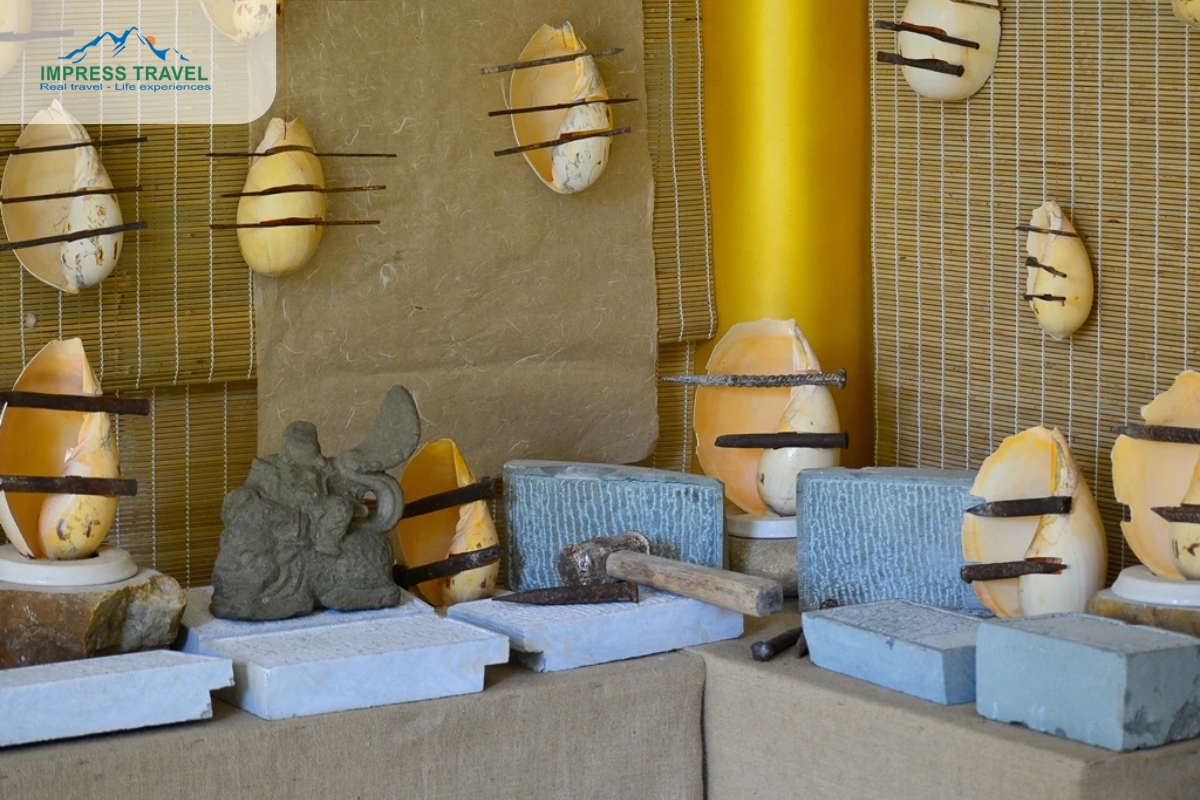The Ngu Hanh Son Stone Carving Memory Museum is located at the foot of Thuy Son Mountain in Danang. It is a storehouse for the treasured heritage of Non-Nuoc village. The village had experienced popularity in the tradition of carving stones since many centuries ago, in fact, thousands of centuries. The museum is a warehouse of cultural history, with a special light on the history of stone carving techniques and artistry. In this regard, the museum takes them back in time and acts as a learning structure for many visitors who see ancient crafts. However, the important thing must be that the craft of stone carving should be saved since, besides it being a beautiful work, it represents the culture and history of their region. Being a very essential museum, everything done in the Ngu Hanh Son Stone Carving Memory Museum is for the preservation of heritage in days to come; it never lets knowledge and skill, which is passed on through generations, die. Even the most amateur art expert could see the bridge that spanned between the past and the present in this museum, so it is a must-see for everyone who visits Danang.
Historical Background of Ngu Hanh Son Stone Carving Memory Museum

Ngu Hanh Son Stone Carving Memory Museum
The history of the Non Nuoc stone carving village dates back to around 400 years. This village is located below the Marble Mountains, which have turned into an art activity center since the 17th century. Work got started in the hands of native carvers, who, with crude tools, carved the widespread marble in the area to produce anything from standard household utilities to religious statues. So, over the centuries, the village’s reputation for excellence in carving stone has grown, and its artisans have become famous for all of Vietnam and further afield.
The stone carving craft of Non-Nuoc has played a role in the culture and spiritual life of the region for a long time. Many a historical monument and religious artifacts across the nation owe their existence to the skilled hands of the Non-Nuoc craftsmen. The Non Nuoc stone carving tradition has been appreciated for its value as an intangible cultural heritage at the state level since 2014, thus carrying significant meaning and importance to preserving and developing tradition. The Ngu Hanh Son Stone Carving Memory Museum is specifically intended to celebrate and sustain the Non-Nuoc stone style.
Museum Information

Stone display area
The Ngu Hanh Son Stone Carving Memory Museum is located at Truong Sa Street, Hoa Hai, Ngu Hanh Son, Danang. The excellent location at the foot of Thuy Son Mountain makes it easy to trace traffic to tourists for those exploring the Marble Mountains. It’s purposefully built to infiltrate the feel of nostalgia upon visiting and getting to enjoy the kind of elements of their culture that today’s lives have washed away, but in an excellent modern setup that transverses to give one an incredible feel. In terms of showroom space, it is over 2,000 square meters, comprising both the interior and exterior sections. The internal space is more than 700 square meters, with a vast number of artifacts, tools, and sculptures holistically displayed in an unraveling vividness that spells the story of Non-Nuoc stone carving in the most careful order anachronically, which shows the visitor its historical development.
The outside soaks with such a tranquil atmosphere; and a bunch of different views from the mountain to the sea. “Trăng Nước Xưa" also lends outdoor space to re-enter one’s experience back with light refreshment. This twosome space not only serves for the public impression but also enables a view of the whole tradition of stonework in its original habitat.
Exhibits and Artifacts

Traditional area
Vast collections of exhibits have been chosen painstakingly at the Ngu Hanh Son Stone Carving Memory Museum, each one designed to shine a light onto the enormity and depth that the stonemasonry craft has undergone. Another characteristic of the history and technique may be represented in quite several categories through tools, artifacts, and finished sculptures.
As we witness the display of tools, they exhibit the different kinds of traditional implements of the artisans: chisels, hammers, and all the other carving tools. It shows the manual dexterity and correctness with which it took place for a centuries-old intricate stone sculpture. This museum also contains the evolution of these tools, from the primary and most straightforward hand appliances in the beginning periods until the modern tools of machinery and the inclusion of CNC technology.
Among all these artifacts, ancient stone steles and statues are the most critical evidence as designed for thousands of years and, therefore, present with the characteristics of their era. These samples give historical context and exemplify the religious and cultural importance that carving could hold in any given area. For example, various statues, such as those by Huỳnh Bá Minh Phước Lộc Thọ and that of Tiên cỡi hạc by the artist Hùy Chín, offer a first-rate ideal of the artistic refinement that distinguishes Non-Nuoc stone carving.
Apart from that, even the typical artisans who have lived their whole lives contributing to the profession’s development into present altitudes are also housed in the museum. Some exhibitions of typical artisans like Nguyễn Sang, Lê Bền, and Nguyễn Long Bửu have found international acclaim. The exhibitions are typical specimens that confirm the individual achievements and the shared heritage of the Non-Nuoc stone engraving community.
Carving Stone Art

Statue made from marble at the Marble Stone Carving Memory Museum
The Ngu Hanh Son Stone Carving Memory Museum goes deep into the history of the traditional craft of stone carving, back to the Non Nuoc village. In fact, the techniques are traditionally crafted by hand and, therefore, involve very scrupulous manual processes. This is about the carving of marble into beautiful designs with the use of a variety of chisels and hammers. Such painstakingly manual work is bound to need not only a set of skills but also a good understanding of the possible natural properties of stone. Techniques used in stone carving have gradually evolved. The possibility of adopting modern techniques through the application of CNC machines from purely manual intervention is a new chapter that has come up for the industry. Most of all, designs that are executed are achieved very fast, either simple or complex, and at the same time, maintaining quality in the Non-Nuoc art.
The heart of the craft breathes in the hands of individual craftsmen, who continue to work in the traditional ways—some even picking up a few delicate or detailed works—keeping the authenticity of the art alive. People stand in wonderment in front of beautiful craft and new-age technology brought together by the sheer contrast of ancient and modern at the Ngu Hanh Son Stone Carving Memory Museum. The displays represented the razor-sharp line between the rough manual tools of yesteryears and those used today. Further, the fact that the machines used are detail-oriented speaks about yet another evidence of the love the artisans had for their legacy.
Guest Experience When come to Ngu Hanh Son Stone Carving Memory Museum

Tourists visit Ngu Hanh Son Stone Carving Memory Museum
The Ngu Hanh Son Stone Carving Memory Museum is an experiential mode in itself, comprising enrichment and interactivity. In this perspective, the museum organizes guided tours that dispatch, for the visitor, the history inside the stone-carving techniques and other captivating information on the masters and stories behind the artifacts with very knowledgeable guides. Aside from the workshops, there are also lectures inside the museum. In this way, children and adults can have first-hand involvement in the actual process of stone carving. Indeed, this practical experience heightens the degree of appreciation people will have for the crafts and skills needed to produce such beautiful works of art.
More than that, most underline the experience evoked to make the history and art of Non-Nuoc stone carving come alive. Most come away with a recently inspired appreciation of the artist and their work. Most reviews comment on how well the exhibits at the museum are put together how it makes history, and the techniques come alive through the different forms of presentation.
Cultural and Community Impact

Petrified wood
Situated right at the core of conserving and promoting the cultural heritage of Non-Nuoc village, the Ngu Hanh Son Stone Carving Memory Museum stands for a set of relics, providing education for many programs so that all the knowledge and skills in traditional stone carving will be passed on to the following generations.
The museum itself is dedicated to local artisans; it shows their works and provides them with an opportunity to interact with a larger audience, showing off their skills and knowledge. Interaction like that evokes pride and continuity within the community, where artisans feel that their trade is always being valued and sustained.
It also plays a significant role in local economies and tourism. This facility offers employment through the fact that the many visitors who tour the facility from around the world are treated to the most exquisite scenes that the facility provides and then visit the shopping centers and other local businesses. To those on Danang tours, the museum forms the highlight that brings depth to the traveling experience – that of cultural enrichment together with economic benefits to the locals.
Helpful Information for Travelers
Ngu Hanh Son Stone Carving Memory Museum Day passes are sold from as early as 8 a.m. until 5 p.m. daily. Modest is the entry fee and relatively cheap for whosoever wants to visit it. There are also different concessions for children, students, and pensioners. Situated at R1-R12 Truong Sa, Hoa Hai, Ngu Hanh Son, Danang, hence very convenient for anyone planning to visit the Marble Mountains and any other site that is proximal to it. Facilities on the museum grounds also feature plentiful parking, a café serving light feasts titled “Trăng Nước Xưa," and a gift shop to buy reproductions of the stone sculptures. From signages that can be easily read, to inquiring exhibits, to ease of navigation, the museum is designed to help visitors with orientation and understanding.
I highly advise going through the guided tour, workshop, and indoor and outdoor exhibits. This will enable one to interact with the artisans, and the questions asked shall do much in building a more profound understanding and appreciation of the craft.
Conclusion
Ngu Hanh Son Stone Carving Memory Museum Day passes are sold from as early as 8 a.m. until 5 p.m. daily. Modest is the entry fee and relatively cheap for whosoever wants to visit it Cham Sculpture was a venue for observing the history of time and the delicate works of Non-Nuoc stone carvings. It is a museum of the past, the present, and the future. The truth is that the museum is one of the essential cultural establishments in the city regarding maintaining the artistic legacy of Danang. We welcome all local residents and tourists to come to the museum on a Danang tour so they may help promote this invaluable heritage and place of importance in history. Don’t forget to regularly follow our Fanpage for more interesting information about traveling to Danang and to book Danang tours at the best prices.


































































